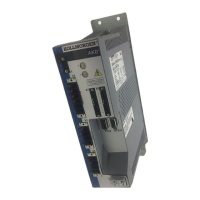8.7 EMI Noise Reduction
8.7.1 Recommendations for EMI Noise Reduction
The following guidelines will help you to reduce problems with electrical noise in your appli-
cation.
l Ensure good connections between the cabinet components.
Connect the back panel and cabinet door to the cabinet body using several conductive
braids. Never rely on hinges or mounting bolts for ground connections. Provide an elec-
trical connection across the entire back surface of the drive panel. Electrically-conductive
panels such as aluminum or galvanized steel are preferred. For painted and other coated
metal panels, remove all coating behind the drive.
l Ensure good ground connection.
Connect from cabinet to proper earth ground. Ground leads should be the same gauge as
the leads to main power or one gauge smaller.
l Use Kollmorgen™ cables.
Experience has shown that customers who use Kollmorgen™’s power and feedback
cables have far fewer problems than customers who build cables.
Route power and control cables separately, Kollmorgen™recommends a distance of at
least 200 mm to improve interference immunity.
If a motor power cable is used that includes cores for brake control, the brake control
cores must be separately shielded.
l Ground the shielding at both ends.
Ground all shielding with large areas (low impedance), with metalized connector housings
or shield connection clamps wherever possible. For cables entering a cabinet, connect
shields on all 360° of the cable. Never connect a simple “pigtail.” For more information on
shielding concepts, ➜ p. 86.
l With separate mains filter, maintain separation of leads entering and exiting the mains
filter (line power filter).
Locate the filter as close as possible to the point where the incoming power enters the
cabinet. If it is necessary for input power and motor leads to cross, cross them at 90°.
l Feedback lines may not be extended, since the shielding would be interrupted and the sig-
nal processing may be disturbed. Install all feedback cables with an adequate cross-sec-
tion, per IEC 60204 (➜ p. 39) and use the requested cable material to reach maximum
cable length.
l Splice cables properly.
If you need to divide cables, use connectors with metal backshells. Ensure that both
shells connect along the full 360° of the shields. No portion of the cabling should be
unshielded. Never divide a cable across a terminal stripe
l Use differential inputs for analog signals.
Noise susceptibility in analog signals is greatly reduced by using differential inputs. Use
twisted-pair, shielded signal lines, connecting shields on both ends.
AKD Installation | 8 Electrical Installation
Kollmorgen™ | May 2013 85

